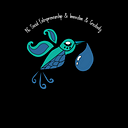RC SDG 13 Climate Action Challenge Design Teams’ Work on Defining Solutions and Prototyping
Author: İpek (Grade 9)
Editor: Barış (Grade 12)
RC Social Entrepreneurship, Innovation, and Creativity Office (RC SEIC) organized the fifth design thinking workshop on defining the solution and financial sustainability with SDG 13 Climate Action Challenge Teams. Mr. Holz joined the circle to give a presentation on Bokashi composting. Ms. Alev Çağlar was also invited to introduce the projects in Aşıklı Höyük. Thanks to them, teams got acquainted with the projects carried inside and outside of Robert College on agriculture.
“This will be a hands-on learning opportunity for the RC community.”
Mr. Holz started by giving a presentation on Bokashi composting. Distinguishing property of Bokashi composting is that bokashi bran is added to the food scraps while being composted. Mr. Holz stated that Robert College is planning to prepare and sell bokashi composting sets to the RC community to help them reduce their wastes at home. To do that, they need students to make more bokashi bran, create a logo for the bokashi bran bag and barrel, and work with the plant office to track finance. Mr. Holz emphasized that this will be a hands-on learning opportunity for the RC community.
Aşıklı Höyük: More Than a Village
Alev Çağlar continued by introducing teams to Aşıklı Höyük — the oldest neolithic settlement in Middle Anatolia. Alev Çağlar is a member of Aşıklı Höyük Dostları Derneği, which works on “Neolithic Food Forest”, in which they examine the human-nature relationship based on the excavations and mimic agriculture methods used in the past. Another project they are currently working on is the “Oral History Project”, through which they ask questions to villagers about the agriculture methods being used before technology.
Define Your Solution!
Teams discussed whether they would like to work on any of the projects presented by Mr. Holz and Ms. Alev Çağlar or not. Then, they went into the breakout rooms to write solution statements based on the solution ideas they came up with in the previous workshop. Solution statements included the problem statement, solution, and the impact being created.
How to Create a Business Model?
Next, Soykan (RC’23) gave a presentation on designing business models for social impact. A business model is the core decisions that determine the economics of a venture regarding its cost structure, revenue sources, and capital requirements. It is vital for financial sustainability, efficiency, and scalability. The following four guidelines should be kept in mind while designing a business plan:
- Form your operation model by thinking of different possibilities and testing them.
- Take advantage of existing resources.
- Determine your pricing strategy, sources of earned income, and capital structure.
- Choose your scaling strategy wisely.
Then, teams were asked to fill out the business model worksheet as well as the lean canvas.
In the following workshop, teams presented their lean canvas to the whole group. They were asked to be specific and precise about everything they wrote on the canvas. Also, Ms. Oğuz suggested that they check the projects with similar goals and try to have something unique for their projects.
Prototyping
Teams were introduced to the last stage of design thinking: prototyping. In this stage, project ideas become a reality. Prototypes can be in the form of a storyboard, a 2D or 3D model, a sketch, and etc. Prototyping for testing is done by probing different aspects of the design solution rather than the whole solution at once. In breakout rooms, teams identified two aspects of their projects that they were concerned about and created a prototype of them.
Teams Reflecting Back On Their Journey
At the end of this workshop, SDG 13 Climate Action Challenge Teams and the facilitators shared their takeaways from their 6-month journeys. Here are some of the insights they gained:
- Conducting interviews in the empathy stage was a new experience for me.
- I was empowered by being in such a supportive circle in which young people gather to heal the world.
- I used to be a judgmental person, but I learned to give and receive constructive feedback.
- We have the power to do more than we expect.
- Being a part of the right team brings good ideas to the table.
- I learned how to act wisely in times of crisis.
What is your takeaway from this article? Share your comments with us.
